Daopao
Daopao (Chinese: 道袍; pinyin: dàopáo; lit. 'Taoist robe'), also known as xuezi (Chinese: 褶子) when used in Chinese opera performance[1][2]: 181 and deluo (Chinese: 得罗) when it is blue in colour,[3][4] is one of the most common traditional Chinese garment worn by men.[5] Daopao literally means "Taoist robe";[6][7] however, despite its name, the daopao were and is worn by men, and did not imply that its wearer had some affiliation to taoism.[5]
| Daopao | |||||||
|---|---|---|---|---|---|---|---|
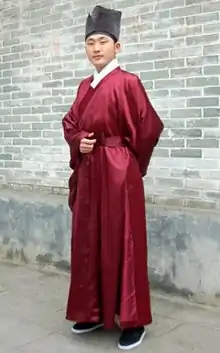 Daopao (道袍)/ Xingyi (行衣) - formal wear for men | |||||||
| Chinese | 道袍 | ||||||
| Literal meaning | Taoist robe | ||||||
| |||||||
The daopao is also one of the most distinctive traditional clothing of the Han Chinese.[8] The daopao dates back to at least the Ming dynasty[5] and has been worn since the Song dynasty.[9] Initially the daopao was a form of casual clothing which was worn by the middle or lower class in the Ming dynasty.[1] In the middle and late Ming, it was one of the most common form of robes worn by men as casual clothing.[8] The daopao was also a popular formal wear by the Ming dynasty scholars in their daily lives.[2]: 77 It was also the daily clothing for the literati scholars in the Ming dynasty.[2]: 181 In the late Ming, it was also a popular form of clothing among the external officials and eunuchs sometimes wore it.[10]
The daopao (Taoist robe) can also refer to the clothing worn by practitioners of taoism;[11]: xvii this form of daopao worn taoist practitioners and taoist monks continued to be worn in the Qing dynasty as they were exempted from the tifayifu policy.[2]: 181 The Taoist's daopao also continue to be worn by modern taoist priests, although it may come in different names.
Origins
Chinese sources indicate daopao have been worn since the Song Dynasty (960–1279).[9] The daopao was worn by Taoist priests after 960 AD to distinguish themselves from others.[12]
Other sources state that a form of daopao without a cord has evolved from a military-styled tunic known as the kuzhe. The kuzhe was inspired by nomad warriors from the north.[13]
During the Ming dynasty, the traditional clothing system of the Han Chinese was restored.[8] However, the shape of some clothing was however different to the ones worn in the Tang and Song dynasties and the clothing in the Ming had a series of adjustments to their shapes.[8]
Construction and Design
The shape of the Ming dynasty daopao, and its colours, was strictly regulated by the political systems, rules and regulations of the time.[8] The Ming dynasty daopao has a cross collar which closes at the right side in the front, it has a large frontal outer placket and smaller frontal inner placket.[8] The sleeves are large but are narrower around the wrists.[8] It is a full-length, wide-sleeved robe which is not completely stitched at the two sides and allows for side slits to begin below the waist level.[5][8] There is a pair of ties at the small placket and two pairs of ties on the large placket which is used for closing the garment.[8] The neckline of the robe is often decorated with white or plain collars.[8] At the sides of the robes, there are side panels in the form of concealed swing or pendulum structure (i.e. a front and back swings at each sides of the robe).[8]
Side panels (暗擺, àn bǎi) at these slits conceal undergarments. A belt (大帶, dà dài) fastens the garment around the waist. The collar can be either the same or a different colour to the main pieces of fabric. However, the collar is generally the same colour as the hems. An optional additional protective collar (simplified Chinese: 护领; traditional Chinese: 護領; pinyin: hù lǐng; lit. 'protective collar') can be sewn to the first collar. This additional collar can either be white or dark in colour. In total the structure of the robe is made up of 10 parts.[8]
 Ming Dynasty portrait of men wearing daopao
Ming Dynasty portrait of men wearing daopao Difference between daopao and shenyi.
Difference between daopao and shenyi..jpg.webp) Ming dynasty style daopao.
Ming dynasty style daopao.
Xuezi
In the Qing dynasty, performers in Chinese theatres were allowed to wear hanfu as they were exempted from the tifayifu policy.[14] The xuezi which is worn in Chinese opera is a derivative of the Ming dynasty daopao and became one of the most common costumes worn on stage; it was derived from the Ming scholars in formal, daily life dress.[2]: 77, 181 The xuezi is a form of informal dress when worn by performers from the wenxiaosheng (civil xiaosheng)[15]: 3 and sheng (standard male, including the xiaosheng (young men))[15]: 31–32 role types. Wenxiaosheng often wears xuezi of pastel colours, which is embroidered with flowers and has water sleeves.[15]: 3, 6 Performers playing female roles could also wear xuezi called nüxuezi, which was also an informal robe.[15]: 54
The xuezi is also one of the derivatives of the jiaoling pao (long robe with y-shaped closure closing to the right), which dates from the Zhou dynasty.[15]: 54 The xuezi is structurally different from the jiaoling pao: the xuezi has a trapezoid body, narrower sleeves which is tubular in shape, the sleeves are longer than the wrists, and water sleeves are also added; there is an asymmetrical closure where the right side is right below the shoulder and neck intersection while the left crossing over is tied right under the right arm.[15]: 54 Men wear a full-legnth xuezi while women wear knee-length xuezi; the male xuezi has y-shaped closure while there are two types of nüxuezi, one which has a y-shaped closure and one which has front central closure.[15]: 54, 276–294
Taoist priest's clothing
Daofu
Daofu (Chinese: 道服; pinyin: dàofú; lit. 'Taoist priest robe') are broad and elegant robes which were initially worn by Taoist priests.[16] In the Song dynasty, the daofu was very popular.[16] It was greatly appreciated by some hermits and scholars during the Song dynasty and was mentioned in some poems written by Wang Yucheng and Fan Zhongyan.[16] Some scholars, such Shi Manqing (994–1041), and some officials in retirement also liked to dressed in daofu.[16] There were many forms of daofu in the ancient China.[4]
In the Ming dynasty, the daofu is a wide-sleeved, crossed-collar robe which closes to the right and has dark edging at the edges of the collar, sleeves, and placket.[17] In the collar edge, a collar protector known as huling (simplified Chinese: 护领; traditional Chinese: 護領; pinyin: hù lǐng; lit. 'protective collar') is sometimes inserted.[17] The Ming daofu is similar to the daopao, except for the addition of edges decoration on the robe.[17] Belts like dadai (大带) and sitao (丝绦; i.e. a ribbon or a thin rope made of silk) is also used around the waist when wearing the daofu.[17]
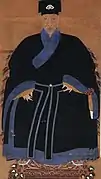 A man wearing a daofu with a dadai belt worn around the waist, Ming dynasty portrait.
A man wearing a daofu with a dadai belt worn around the waist, Ming dynasty portrait.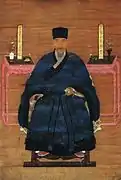 A man wearing a daofu with a huling sewn onto the collar and dadai worn around the waist, Ming dynasty portrait.
A man wearing a daofu with a huling sewn onto the collar and dadai worn around the waist, Ming dynasty portrait.
Daoyi, daogua, and deluo
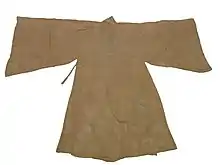

The traditional clothing worn by the Taoists community is connected to pre-modern Chinese clothing and styles.[18] Tradition-based taoists will often wear the traditional robes and liturgical clothing for formal religious and ritual occasions while Zhengyi priests and taoists priests outside mainland China tend to wear Western clothing in their daily lives.[18] The traditional taoist robes can also be worn as a daily lives clothing by the Quanzhen monastics in mainland China.[18]
The Quanzhen monastic taoist priests and nuns wear a wide-sleeved, cross-collared gown called daoyi (道衣; lit. "robe of the Dao") which closes to the right; it is a standard type of clothing.[18] The sleeves of the daoyi is referred as "cloud sleeves"; they are wide, open at the ends, and their sleeves are so long that it is past the fingers when extended but can be even longer.[18] In the Quanzhen order, the dagua is worn as one of the ordinary clothing while the deluo is a formal clothing.[19]
.jpg.webp)
The deluo (得罗) is a cross-collared gown with large sleeves.[20] It is worn by Taoist priests of the Quanzhen order is a formal ritual dress which is indigo in colour.[19] The blue colour is a symbolism for the east and represents having been descended from the first patriarch of the Quanzhen school, Donghua dijun.[19] In large temples (e.g. Baiyunguan in Beijing), the deluo would be worn by monastics on festival days; the deluo would have wide sleeves which could reach 45 cm.[7]
In the Wengong temple in Hanzhong, the cross-collar daopao is the standard form of attire and is referred as daogua (Chinese: 道褂; lit. 'Taoist robe or jacket' depending on context).[7] Their daopao is cross-collared at the front, and the sleeves are so long that only the fingers can escape from the sleeves.[7] It is made of thick garments and is blue or black in colour.[7] The daogua can be found in 3 types: dagua (Chinese: 大褂; lit. 'great gown'; a long cross-collar robe which reaches the ankles and has a 42 cm wide sleeves), zhonggua (中褂; a cross-collar robe which reaches the mid-calf and has slightly narrower sleeves than the dagua), and xiaogua (小褂; a cross-collar robe which reaches the hip and has sleeves which could either be the same size or narrower than a zhongua; the xiaogua is more similar to a jacket than a robe).[7]
Daopao/ hechang
Some forms of taoist robes are also referred as crane robes (hechang, 鶴氅).[21] The Taoist priests' daopao which date back to at least the 1800s is not cross collared and instead looks like a beizi in terms of construction and design; a clothing artefact showing this style of daopao is now stored in museums such as the Rhode Island School of Design Museum.[22] This form of Taoist priests' daopao is worn by middle-ranks Taoist priests; it is red in colour and has motifs at the back and front, on the sleeves.[22][19] Theses motifs decorations can include, the bagua and cranes.[19]
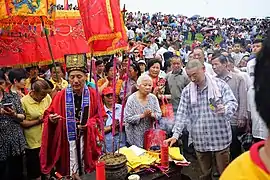 A taoist priest wearing a modern-day taoist's daopao (depicted as a red overcoat), 2017.
A taoist priest wearing a modern-day taoist's daopao (depicted as a red overcoat), 2017.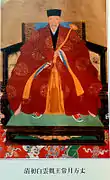 Wang Changyue, Qing dynasty.
Wang Changyue, Qing dynasty.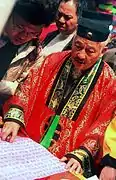 Taoist Priest in Macau, 2006.
Taoist Priest in Macau, 2006.
Similar garments
- Sengyi (僧衣) - Long buddhist robes abbot.
- Hai Qing (海青) - Buddhist ritual garment.
- Zhiduo, also known as zhishen (直身) - a style similar to the daopao except that it was decorated with outside pendulums.[10]
- Dopo (clothing) - A Korean equivalent
See also
References
- Ye, Tan (2020). Historical dictionary of Chinese theater (Second ed.). Lanham. p. 48. ISBN 978-1-5381-2064-4. OCLC 1128888776.
- Wang, Guojun (2020). Staging personhood : costuming in early Qing drama. New York. ISBN 978-0-231-54957-8. OCLC 1129398697.
- Pi lu si bi hua. Dianfeng Kang, 康殿峰. (Di 1 ban ed.). Shijiazhuang Shi: Hebei mei shu chu ban she. 1998. p. 244. ISBN 7-5310-1111-5. OCLC 43293523.
{{cite book}}: CS1 maint: others (link) - DayDayNews (2019-09-08). "What are the forms of Taoist robe and robes? do you know?". daydaynews.cc. Retrieved 2021-08-14.
- Gwynne, Paul (2017). World religions in practice : a comparative introduction (Second ed.). Hoboken, NJ. p. 222. ISBN 978-1-118-97227-4. OCLC 972639879.
- "From the Land of the Immortals | RISD Museum". risdmuseum.org. Retrieved 2021-04-05.
- Herrou, Adeline (2016). A World of Their Own : Daoist Monks and Their Community in Contemporary China. St Petersburg: Three Pines Press. pp. 43–45. ISBN 978-1-365-53752-3. OCLC 1011219060.
- song, Ma; yue, Li; xiaogang, Wang (2021-07-01). "Research on the Ming Dynasty Dao Robe Modeling Method Based on 3D Simulation Technology". Journal of Physics: Conference Series. 1965 (1): 012040. doi:10.1088/1742-6596/1965/1/012040. ISSN 1742-6588.
- 周锡保 (Oct 1986). 《中国古代服饰史》 (PDF) (in Chinese) (2nd ed.). 中国戏剧出版社: 263. Retrieved May 17, 2009.
{{cite journal}}: Cite journal requires|journal=(help) - Yuan, Zujie (2007). "Dressing for power: Rite, costume, and state authority in Ming Dynasty China". Frontiers of History in China. 2 (2): 181–212. doi:10.1007/s11462-007-0012-x. ISSN 1673-3401. S2CID 195069294.
- Wang, Richard G. (2012). The Ming prince and Daoism : institutional patronage of an elite. New York: Oxford University Press. ISBN 978-0-19-990989-6. OCLC 796803927.
- Snodgrass, Mary Ellen (2015). World Clothing and Fashion : an Encyclopedia of History, Culture, and Social Influence. Hoboken: Taylor and Francis. p. 488. ISBN 978-1-317-45167-9. OCLC 910448387.
- Antonia Finnane (2007). Changing clothes in China: fashion, history, nation. Columbia University Press. pp. 44–45. ISBN 978-0-231-14350-9.
- Su, Wenhao (2019). "Study on the Inheritance and Cultural Creation of Manchu Qipao Culture". Advances in Social Science, Education and Humanities Research. Atlantis Press. 368: 208–211. doi:10.2991/icassee-19.2019.41. ISBN 978-94-6252-837-6.
- Bonds, Alexandra B. (2008). Beijing opera costumes : the visual communication of character and culture. Honolulu: University of Hawaiʻi Press. ISBN 978-1-4356-6584-2. OCLC 256864936.
- Zhu, Ruixi; 朱瑞熙 (2016). A social history of middle-period China : the Song, Liao, Western Xia and Jin dynasties. Bangwei Zhang, Fusheng Liu, Chongbang Cai, Zengyu Wang, Peter Ditmanson, Bang Qian Zhu (Updated ed.). Cambridge, United Kingdom. p. 21. ISBN 978-1-107-16786-5. OCLC 953576345.
- "Chinese Traditional Costume - Ming Style Daofu for Male". www.newhanfu.com. Retrieved 2021-08-14.
- Komjathy, Louis (2013). The Daoist tradition : an introduction. London. p. 290. ISBN 978-1-4411-1669-7. OCLC 819275585.
- The encyclopedia of taoism. Fabrizio Pregadio. Richmond: Curzon. 2002. p. 457. ISBN 978-1-135-79634-1. OCLC 810277082.
{{cite book}}: CS1 maint: others (link) - "What is Taoist Clothing? - 2021". www.newhanfu.com. 2020. Archived from the original on 2021-01-25. Retrieved 2021-04-05.
- Zhuo, Xinping (2018). Religious faith of the Chinese. Singapore. p. 44. ISBN 978-981-10-6379-4. OCLC 1017489156.
- "Daopao (Taoist priest's robe) | RISD Museum". risdmuseum.org. Retrieved 2021-04-05.